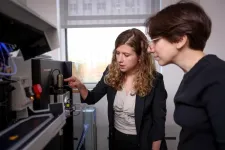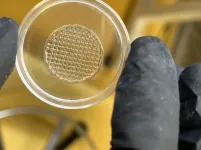(Press-News.org) New York City, New York (April 3, 2025) – The Chan Zuckerberg Biohub New York (CZ Biohub NY) today announced nine new investigators to its growing roster of talented researchers. Joining from Columbia University, The Rockefeller University, and Yale University, the eight projects will focus on the Biohub’s mission to harness and bioengineer immune cells for the early detection, prevention, and treatment of a broad spectrum of age-related diseases, including neurodegenerative disorders and aggressive cancers. The funded projects support a variety of innovative strategies, including leveraging synthetic biology to address the limitations of current immune cell therapies and using models to enable insights into cellular networks and tissue adaptations in health and disease.
“We are excited to welcome these new investigators to our collaborative community of researchers,” said Andrea Califano, Dr, president of CZ Biohub NY and the Clyde and Helen Wu Professor of Chemical and Systems Biology at Columbia University Vagelos College of Physicians and Surgeons. “They are joining us as we pursue a complex challenge to harness the natural capabilities of our immune cells to detect and fix abnormalities in our bodies at very early stages. I look forward to their contributions and how we can shed light on biology’s hidden intricacies, making real progress toward detecting and preventing disease.”
Diseases are often diagnosed only after obvious symptoms appear, while early signals that precede disease are generally missed. Immune cells are well suited to meet this challenge, as they constantly monitor and maintain the health of organs and tissues while circulating through the blood and lymphatic systems. By deciphering the molecular language employed by these cells to report problems they’ve identified, researchers can leverage and augment the cells’ abilities to spot and even treat hard-to-detect cancers and diseases that usually evade these cells. Better understanding and measuring how immune cells monitor abnormalities also creates enormous potential to program new functions into these cells, allowing them to take therapeutic actions, such as repairing damaged cells or eliminating diseased ones.
The Investigator Program at CZ Biohub NY funds research by scientists, engineers, and technologists from Columbia, Rockefeller, and Yale, and is designed to identify and support researchers by providing them with unrestricted funding to pursue their most innovative and high-impact research projects. The nine new investigators will join a vibrant, collaborative, and supportive research community, gaining access to cutting-edge tools, expertise, and training opportunities.
The second cohort includes nine investigators and eight total projects (Drs. Spina and Worley will collaborate on the same project):
Kivanç Birsoy, Ph.D., The Rockefeller University
Tal Danino, Ph.D., Columbia School of Engineering
Jeffrey Ishizuka, D. Phil., Yale University
Nikhil Joshi, Ph.D., Yale University
Aimee Payne, M.D., Ph.D., Columbia University Vagelos College of Physicians and Surgeons
Esen Sefik, Ph.D., Yale University
Catherine Spina, M.D., Ph.D., Columbia University Vagelos College of Physicians and Surgeons
Ekaterina Vinogradova, Ph.D., The Rockefeller University
Jeremy Worley, Ph.D., Columbia University Vagelos College of Physicians and Surgeons
One of the new investigator projects aims to identify strategies for how to engineer immunity to fight autoimmunity. Aimee Payne, M.D., Ph.D., chair and Herbert and Florence Irving Professor of Dermatology at Columbia University Vagelos College of Physicians and Surgeons, will leverage a novel precision cellular immunotherapy developed by her lab known as chimeric autoantibody receptor T-cells (CAART) to better understand how these living therapies may be used to treat certain types of autoimmune diseases such as pemphigus and myasthenia gravis.
Investigator Nikhil Joshi, Ph.D., associate professor at Yale University, will study how variations in T-cell receptors (TCRs) affect immune cell function, resilience, and adaptability in fighting infections and cancer. Joshi and his team hope to identify factors that enhance immune surveillance and improve immunotherapy strategies.
Investigator Ekaterina (Katya) Vinogradova, Ph.D., assistant professor at The Rockefeller University, will leverage state-of-the-art chemical proteomic platforms to address the challenges of selective targeting of immune proteins with small molecules. She aims to deepen our understanding of T-cells and develop advanced chemical probes for protein visualization or functional modulation. View all CZ Biohub NY Investigators.
CZ Biohub New York is the fourth research institute in the Chan Zuckerberg Biohub Network, a groundbreaking collaborative model for scientific research created and supported by the Chan Zuckerberg Initiative (CZI). CZI is focused on solving four grand challenges that will give scientists the tools to help cure, prevent, or manage all diseases in the coming decades. CZ Biohub NY will take on the challenge of engineering and harnessing the immune system for early detection, prevention, and treatment of disease. Together, CZI and the CZ Biohub Network partner to develop science and technologies that help with understanding how cells and tissues function and increase understanding of human health and disease.
###
About the Chan Zuckerberg Biohub Network
The Chan Zuckerberg Biohub Network is a group of nonprofit research institutes that bring together scientists, engineers, and physicians with the goal of pursuing grand scientific challenges on 10- to 15-year time horizons. The CZ Biohub Network focuses on understanding underlying mechanisms of disease and developing new technologies that will lead to actionable diagnostics and effective therapies. To learn more, visit www.czbiohub.org.
About the Chan Zuckerberg Initiative
The Chan Zuckerberg Initiative was founded in 2015 to help solve some of society’s toughest challenges — from eradicating disease and improving education, to addressing the needs of our local communities. Our mission is to build a better future for everyone. For more information, please visit chanzuckerberg.com.
Press Contact
Chan Zuckerberg Initiative
Lindsey Narkchareon, 650-313-4140
lnarkchareon@chanzuckerberg.com
Quote Addendum
Sohail Tavazoie, M.D., Ph.D., Leon Hess Professor at The Rockefeller University and member of CZ Biohub NY steering committee: “We are thrilled to have these outstanding scientists with diverse scientific expertise join us to tackle these exciting, fundamental, and biomedically important challenges.”
END
Chan Zuckerberg Biohub New York announces new investigators for immune system research to improve human health
Nine researchers receive unrestricted funding for projects to harness the immune system to detect disease and monitor health.
2025-04-03
ELSE PRESS RELEASES FROM THIS DATE:
New research suggests White Americans in areas with higher Black poverty are more likely to blame racial inequality on lack of effort
2025-04-03
New research in Social Psychological and Personality Science shows that White Americans living in counties with higher Black poverty rates are more likely to believe racial equality of opportunity exists, while attributing racial disparities to lack of effort.
Led by Dr. Nicolas Sommet, the research included three studies with over 17,000 participants across hundreds of U.S. counties, using both observational and experimental methods to examine how exposure to racial inequality shapes beliefs about its causes.
"Our findings highlight how the environment we live in shapes how we understand racial inequality," explains ...
Solar wave squeezed Jupiter’s magnetic shield to unleash heat
2025-04-03
A massive wave of solar wind that squished Jupiter’s protective bubble has been detected for the first time.
Scientists at the University of Reading have discovered a solar wind event from 2017 that hit Jupiter and compressed its magnetosphere – a protective bubble created by a planet's magnetic field. This created a hot region spanning half Jupiter's circumference and exhibiting temperatures exceeding 500°C – significantly higher than the typical 350°C atmospheric background temperature.
A new study published today (Thursday, 3 April) in Geophysical Research Letters, describes for the first time a solar burst that scientists now believe hits ...
Cognitive decline comes sooner for people with heart failure
2025-04-03
There are over six million Americans with heart failure who are at greater risk of losing their cognitive abilities earlier in life, a study suggests.
The research team, led by Michigan Medicine, examined the cognitive abilities of nearly 30,000 adults over time, comparing those who did and did not develop heart failure.
The researchers found heart failure is associated with a significant decrease in cognition at the time of diagnosis.
Global cognition and executive functioning also declined more rapidly over the years after heart failure diagnosis, as people with the condition mentally aged the equivalent ...
SMEs’ ability to innovate is strongly tied to the learning and decision-making skills of managers
2025-04-03
The ways in which CEOs learn, apply what they have learned, and make decisions are significant to the innovating capabilities of SMEs, states Jutta Mäkipelkola in her doctoral dissertation at the University of Vaasa, Finland. Her research reveals how the skills of CEOs shape the capabilities of SMEs – and what kind of organisational culture drives innovation.
The importance of capabilities that enhance the innovativeness and renewal of companies has become more apparent during uncertain ...
Researchers recycle wind turbine blade materials to make improved plastics
2025-04-03
PULLMAN, Wash. – A new method to recycle wind turbine blades without using harsh chemicals resulted in the recovery of high-strength glass fibers and resins that allowed Washington State University researchers to re-purpose the materials to create stronger plastics.
The innovation provides a simple and environmentally friendly way to recycle wind turbine blades to create useful products.
Reporting in the journal, Resource, Conservation, and Recycling, the team of researchers cut the lightweight material that is commonly used in wind turbine blades, called glass fiber-reinforced polymer (GFRP), into approximately two ...
Low neighborhood walkability is associated with increased risk of cardiovascular disease
2025-04-03
Milan, Italy – 3 April 2025. Low neighbourhood walkability is associated with increased risk of cardiovascular disease (CVD), according to research presented today at ESC Preventive Cardiology 2025,1 a scientific congress of the European Society of Cardiology (ESC).
The health benefits of physical activity are well established and yet more than a quarter of adults do not meet the recommended guideline of 150 minutes of moderate-intensity physical activity per week.2 “Neighbourhoods designed ...
Common phrases, not fancy words, make you sound more fluent in a foreign language
2025-04-03
Language learners often assume that using rare, complex vocabulary will make their speech sound more fluent. Research suggests that there is a close relationship between formulaic expression usage in speech and acoustic features of oral fluency. This implies that using formulaic expressions leads to faster articulation speed and fewer disruptions during speech. However, in terms of how listeners perceive speakers’ fluency, the role of formulaic expressions has been unclear.
To investigate this, Ph.D. student, Kotaro Takizawa and Research Assistant Professor Shungo Suzuki from Waseda University, Japan, analyzed speech from 102 Japanese speakers ...
Printed skin to replace animal testing
2025-04-03
Directive 2010/63/EU laid down restrictions on animal testing for the testing of cosmetics and their ingredients throughout the EU. Therefore, there is an intense search for alternatives to test the absorption and toxicity of nanoparticles from cosmetics such as sun creams. A team of researchers from Graz University of Technology (TU Graz) and the Vellore Institute of Technology (VIT) in India is working on the development of skin imitations that mimic the native three-layer tissue structure and biomechanics of human skin. Such imitations can be produced ...
Precision medicine could be possible in the fight against antibiotic resistance
2025-04-03
The first-of-its-kind in-depth bacterial evolutionary map could pave the way for the development of precision treatments for certain antibiotic-resistant infections, such as urinary tract infections.
Researchers at the Wellcome Sanger Institute, the University of Oslo, UiT The Arctic University of Norway, and their collaborators, have developed a new way of using large-scale long-read sequencing data to investigate circular genetic structures called plasmids in the most commonly studied microbe, Escherichia coli (E. coli). Through this, the team were able to track the flow ...
Researchers at the Lewis Katz School of Medicine at Temple University identify new targeted approach to protect neurons against degeneration
2025-04-03
(Philadelphia, PA) – Neurodegenerative conditions such as Parkinson’s disease and Alzheimer’s involve progressive neuronal loss due to disease-induced damage. An enzyme known as dual leucine-zipper kinase (DLK) plays a key role in this process, telling neurons that are damaged or unhealthy when they should cut their losses and self-destruct. Hence, sparing neurons from DLK is an attractive therapeutic strategy that could slow disease progression.
Past attempts to inhibit DLK’s action in human patients, however, led to unexpected side effects affecting the nervous system, suggesting that DLK ...
LAST 30 PRESS RELEASES:
Norbert Holtkamp appointed director of Fermi National Accelerator Laboratory
New agentic AI platform accelerates advanced optics design
Biologists discover neurons use physical signals — not electricity — to stabilize communication
Researchers discover that a hormone can access the brain by hitchhiking
University of Oklahoma researcher awarded funding to pursue AI-powered material design
Exploring how the visual system recovers following injury
Support for parents with infants at pediatric check-ups leads to better reading and math skills in elementary school
Kids’ behavioral health is a growing share of family health costs
Day & night: Cancer disrupts the brain’s natural rhythm
COVID-19 vaccination significantly reduces risk to pregnant women and baby
The role of vaccination in maternal and perinatal outcomes associated with COVID-19 in pregnancy
Mayo Clinic smartwatch system helps parents shorten and defuse children's severe tantrums early
Behavioral health spending spikes to 40% of all children’s health expenditures, nearly doubling in a decade
Digital cognitive behavioral treatment for generalized anxiety disorder
Expenditures for pediatric behavioral health care over time and estimated family financial burden
Air conditioning in nursing homes and mortality during extreme heat
The Alps to lose a record number of glaciers in the next decade
What makes a good proton conductor?
New science reporting guide published for journalists in Bulgaria
New international study reveals major survival gaps among children with cancer
New science reporting guide published for journalists in Turkey
Scientists develop a smarter mRNA therapy that knows which cells to target
Neuroanatomy-informed brain–machine hybrid intelligence for robust acoustic target detection
Eight SwRI hydrogen projects funded by ENERGYWERX
The Lundquist Institute and its start-up company Vitalex Biosciences Announces Strategic Advancement of Second-Generation fungal Vaccine VXV-01 through Phase 1 Trials under $40 Million Competitive Con
Fine particles in pollution are associated with early signs of autoimmune disease
Review article | Towards a Global Ground-Based Earth Observatory (GGBEO): Leveraging existing systems and networks
Penn and UMich create world’s smallest programmable, autonomous robots
Cleveland researchers launch first major study to address ‘hidden performance killer’ in athletes
To connect across politics, try saying what you oppose
[Press-News.org] Chan Zuckerberg Biohub New York announces new investigators for immune system research to improve human healthNine researchers receive unrestricted funding for projects to harness the immune system to detect disease and monitor health.




